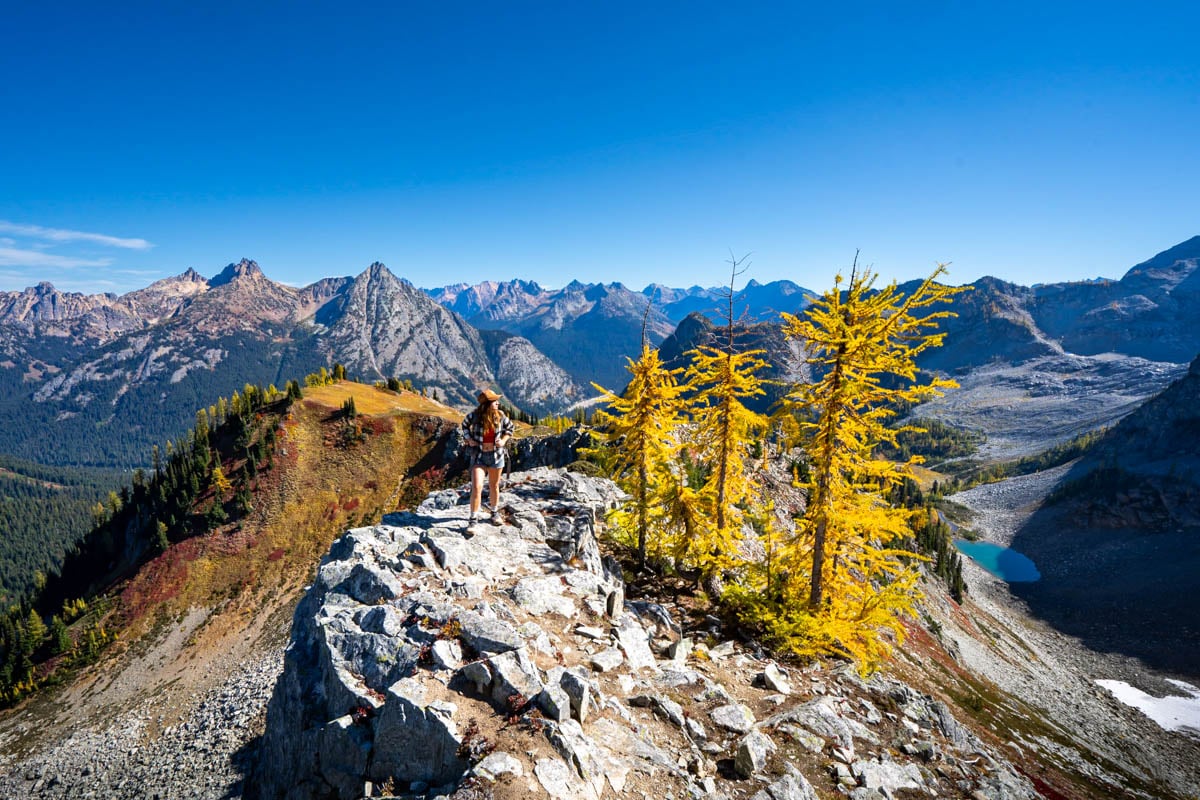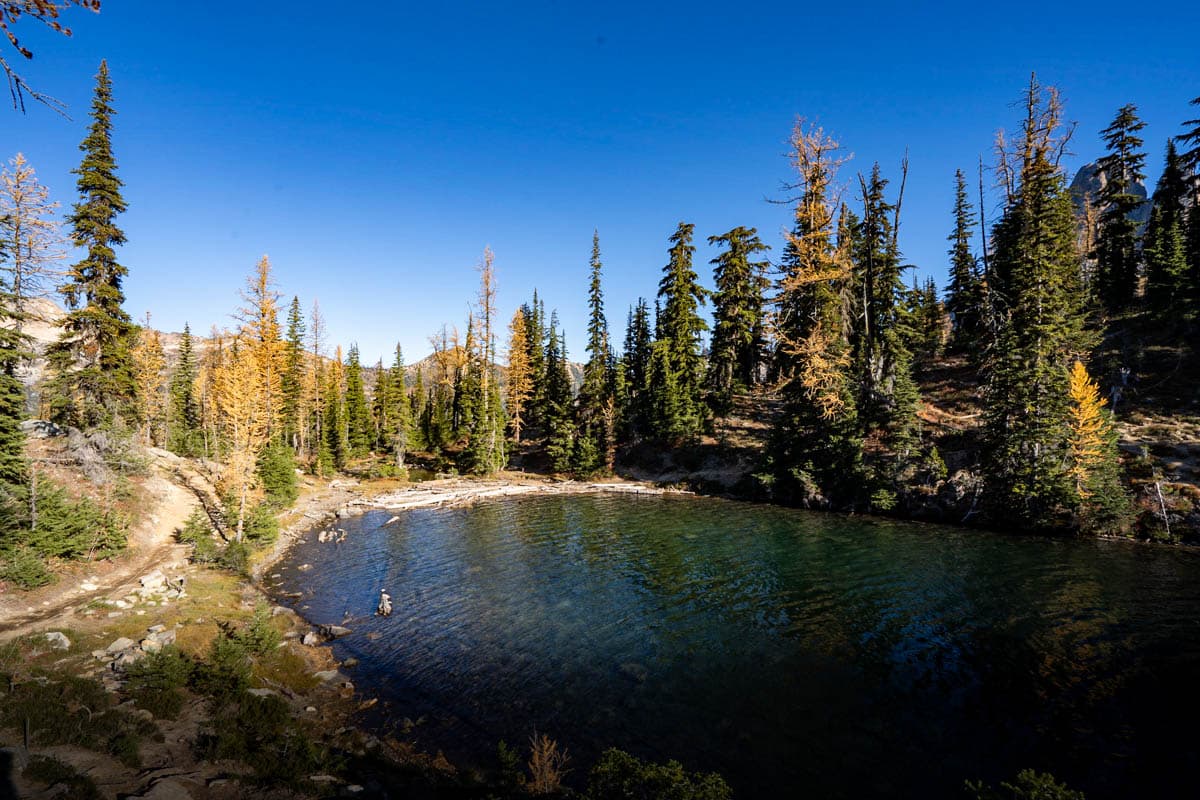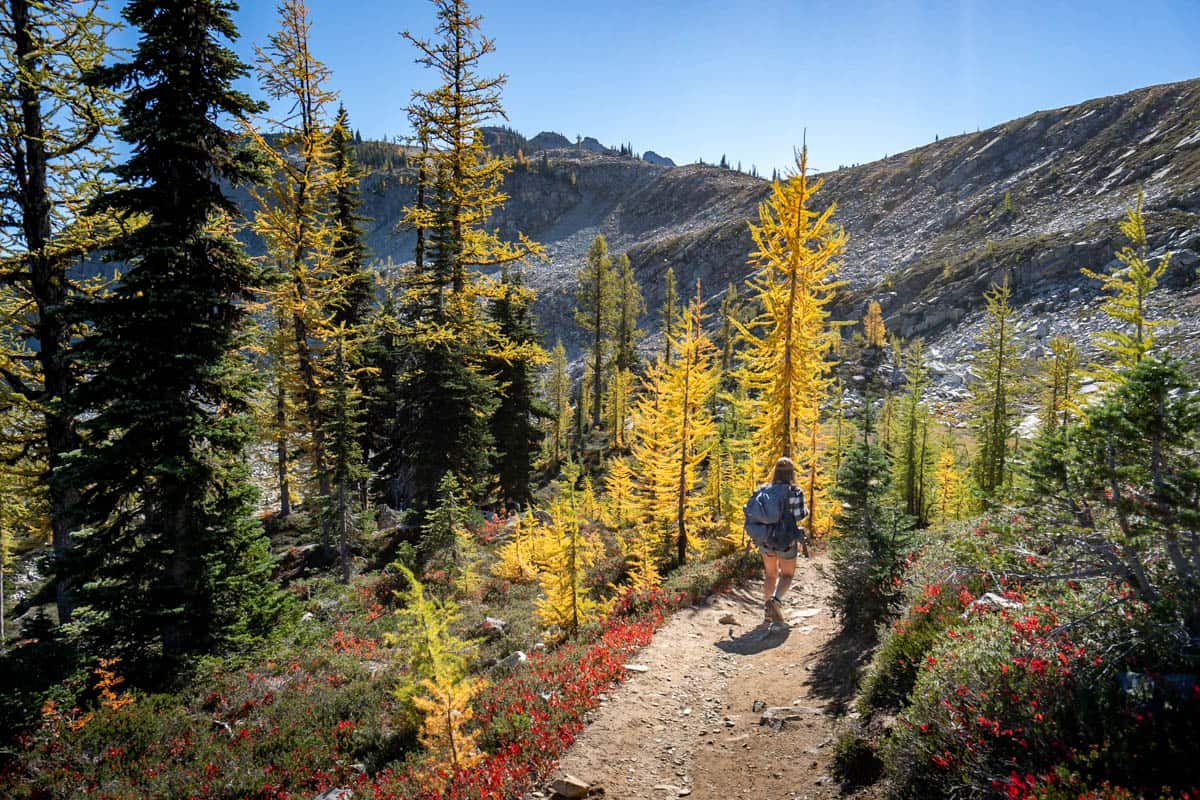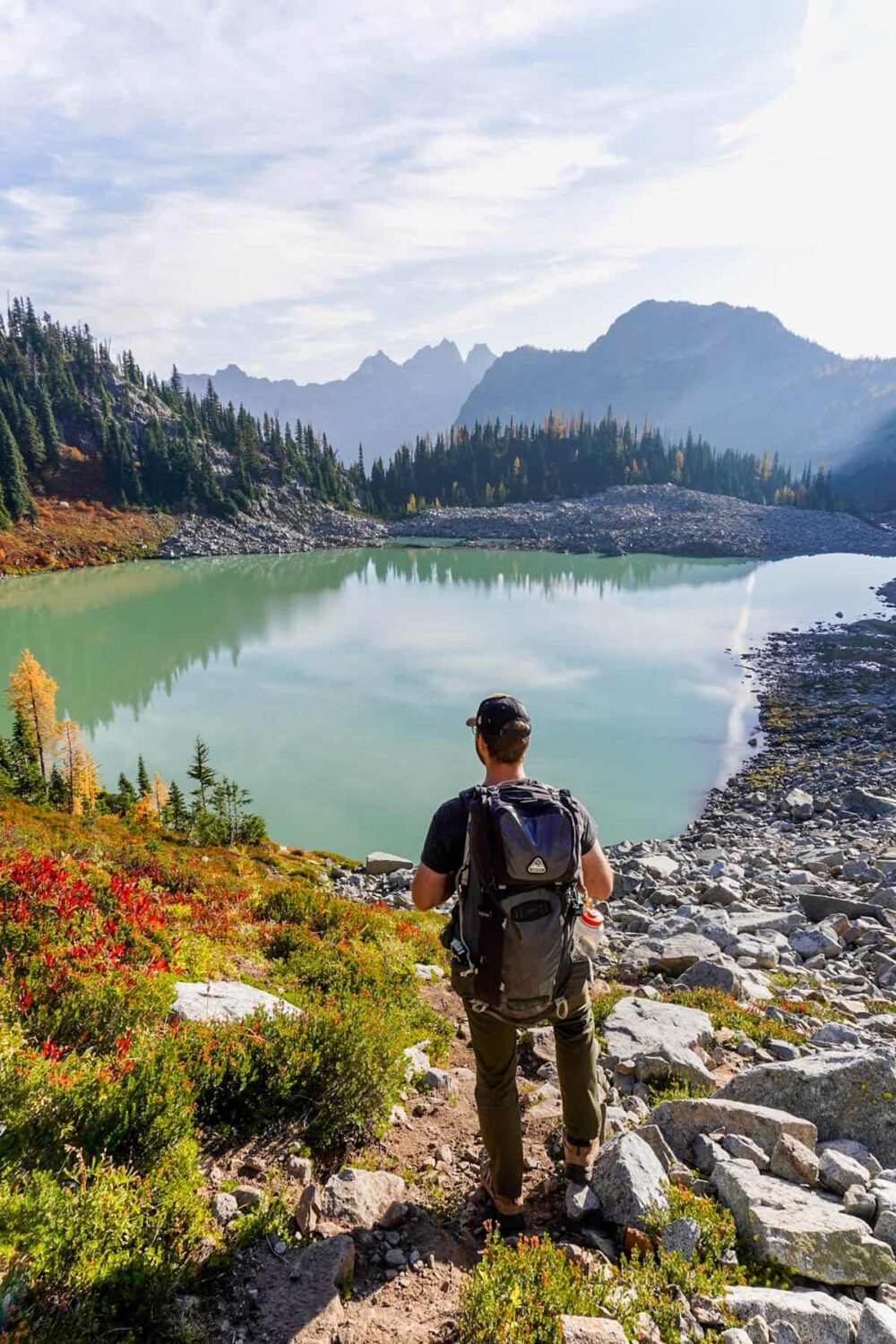When you think of gorgeous fall foliage, you may not necessarily consider Washington state and its dense pine tree forests. But, come fall, something quite magical happens in Washington–its larch trees, a unique kind of conifer, turn stunning shades of blazing gold. If you want to see this autumn spectacle for yourself, here’s the 7 of the best larch hikes in Washington.
This post may contain affiliate links. If you make a purchase through them, we may receive a small commission, for which we are extremely grateful, at no extra cost to you.

Frequently Asked Questions About Larches in Washington
Before we dive in, let’s cover some of the basics.
What are larches?
Larches, also called tanaracks, are needle-bearing conifers, just like cedar trees or Western hemlocks. However, they have something quite unique about them—they’re actually deciduous, which means they’re the type of tree whose leaves or needles fall off at maturity.

Larches are one of the few conifers on the planet whose soft needles turn a flaming shade of gold in the autumn before falling off for the winter.
They’re only found in specific elevations in certain types of cold and mountainous terrain, including in the Cascade Mountains in Washington, areas of Canada, and Siberia.
When can you see larches in Washington?
The larches turn their beautiful gold each autumn, but the exact time frame changes year-to-year, based on a number of factors.

Generally, though, the larches in Washington typically change in the last couple of weeks of September through the first week of October. Come mid-October, many of the trails and sometimes even roads at high elevations throughout the Cascade Mountains will receive their first dumping of snow and ice for the wintertime and may even become inaccessible until the following summer.
Best Larch Hikes in Washington
Without further adieu, let’s talk about the best trails to see larches!
1. Heather Maple Pass Loop
- Length: 7.2 miles
- Elevation gain: 2,191 feet
- Difficulty: Challenging
- Fee: $5 for day use or free with an America the Beautiful Pass
- Trail map
Every fall, my husband, Justin, and I make a pilgrimage to the Northern Cascades to see the golden larches. So I am TOTALLY biased here, but this is my favorite area of Washington to see these beautiful trees.

Inarguably, one of the best hikes to see larches in the North Cascades is the Heather Maple Pass Loop, which leads you up past two alpine lakes, several mountain passes, and, of course, countless groves of larch trees. At the very top of the hike, you’ll have jaw-dropping, panoramic views of the surrounding Cascade Mountain peaks, covered with autumnal foliage—it seriously looks like some kind of autumnal Candyland!
You have two options to hike the Heather Maple Pass Loop.
The most popular option, by far, is counterclockwise, where you’ll gradually climb through a wooded forest, past Ann Lake and, eventually, make a steep descent. Only a fraction of hikers complete the trail clockwise, climbing up steeply through a forest to Maple Pass and then walking down a more gentle descent.

We’ve hiked this trail both ways in autumn and personally prefer clockwise, given there’s WAY less people heading in the same direction that you have to play leapfrog with and you can just enjoy the beautiful views of the foliage and alpine lakes on your way down the trail, instead of being worried about tripping on the steep and rocky descent. But you’ll love the stunning views—and the larches—either way!
Just be forewarned that this is one of the most popular fall hikes in Washington, so expect to share the trail with LOTS of other larch enthusiasts. For the most peaceful experience, try to go on a weekday or REALLY early (like, immediately after sunrise early) to enjoy this hike without your closest thousand hiker friends.
2. Blue Lake Trail
- Length: 4.6 miles
- Elevation gain: 915 feet
- Difficulty: Moderate
- Fee? $5 for day use or free with an America the Beautiful Pass
- Trail map
For something a bit more on the moderate side, the Blue Lake Trail in the North Cascades is an excellent larch hike.

You’ll hike the first mile or so of this trail up a gentle incline through a beautiful pine tree forest, which will eventually open up to several groves of larch trees and views of the surrounding mountains, including Cutthroat Peak and Whistler Mountain. Make sure to look up at the mountains—most of them have entire swaths of golden larches, scattered across their slopes!
Two miles into the trail, you’ll reach the appropriately named Blue Lake, a turquoise pool, surrounded by flaming gold larch trees and sitting in the shadow of a dramatic mountain, with plenty of snow patches that last throughout the season.

There’s a trail that follows along most of its lakeshore, but if you just want to relax and take in the views, there’s a large rock on the western side of the lake, jutting into the lake, that provides an awesome spot to sit back, have a snack, and take in the stellar views.
This trail is probably the second most popular larch hike in the North Cascades, so be prepared to share the trail with others. For the most peaceful experience, visit on a weekday or get here first thing in the morning.
3. Cutthroat Lake
- Length: 3.8 miles
- Elevation gain: 479 feet
- Difficulty: Easy
- Fee? $5 for day use or free with an America the Beautiful Pass
- Trail map
Cutthroat Lake is probably the easiest larch hike in Washington, weaving along a dusty path that gently climbs uphill.
The trail is lined with shrubs and wildflowers that, come autumn, turn spectacular shades of scarlet and orange. Plus, you’ll get peekaboo glimpses through clearings of the pine trees of the jagged peaks of the North Cascades surrounding you.

Less than two miles into the trail, you’ll reach the marshy banks of Cutthroat Lake, with plenty of colorful foliage surrounding its shores. Beyond the lake, you’ll have stunning views of Cutthroat Peak and the neighboring Cascades, whose slopes are littered with pines and golden larches.
4. Cutthroat Pass
- Length: 11.4 miles
- Elevation gain: 2,473 feet
- Difficulty: Challenging
- Fee? $5 for day use or free with an America the Beautiful Pass
- Trail map
Cutthroat Pass Trail is one of the most under-the-radar larch hikes through the North Cascades—but it’s also one of the most epic!

This hike is a continuation of the Cutthroat Lake Trail, where you’ll climb up a series of switchbacks that gradually climb up the mountain. Most of the trail is densely forested, with occasional clearings that provide jaw-dropping views of the surrounding mountain peaks.
The further along the trail you go, the pine trees will clear, with more and more larches and vibrant wildflowers and shrubs, ablaze with fall colors. As you approach the ridge of the mountains, the trees will clear and provide absolutely jaw-dropping views of the North Cascades and their slopes, blanketed with larches, to the south.

Justin and I have hiked hundreds of trails in the Pacific Northwest and only a few have made me cry with their beauty—and Cutthroat Pass is one of them!
5. Colchuck Lake Trail
- Length: 8.7 miles
- Elevation gain: 2,342 ft
- Difficulty: Challenging
- Fee? $5 for day use or free with an America the Beautiful Pass
- Trail map
The Colchuck Lake Trail is one of the most popular hikes in the Alpine Lakes Wilderness. This wilderness area is a popular day trip from the quirky town of Leavenworth, a Bavarian-themed village, nestled in the North Cascades, which is worth putting on your bucket list in and of itself (if you haven’t experienced Christmas in Leavenworth, DO IT!!!).
Colchuck is part of the Enchantments, a beloved group of jewel-colored alpine lakes, tucked amongst the rugged peaks of the Cascades.

To reach the storied lake, you’ll climb along a rocky and dusty trail through a pine tree forest. Keep an eye out—about 2.1 miles into the trail, it will fork, with the path to the right leading you to Stuart Lake and the one to the left leading you to Colchuck. Stuart is absolutely beautiful, but if it’s larches you’re after (and, if you’re reading this article, I imagine you are!), be sure to continue left up to Colchuck.
From here on, the trail will get noticeably steeper, with a few river crossings and plenty of views of the surrounding mountains. But your hardwork will be worth it once you reach the robin’s egg blue waters of Colchuck Lake, which perfectly contrasts with the golden larches, surrounding the shoreline. Beyond, the snowy Dragontail Peak makes the lake look even more dramatic.
If you’re visiting on an unseasonably warm day, consider dunking your feet (or even your whole body!) into the lake’s chilly waters—it’ll definitely wake you right up for the return hike!
Psssst... Leavenworth has an awesome Oktoberfest each year, usually the first couple of weekends of October. Depending on when larch season is, you may be able to book a night or two at one of the awesome hotels in Leavenworth and make a whole weekend out of enjoying the larches at Colchuck Lake and Oktoberfest in one fell swoop.
6. The Enchantments
- Length: 18.0 mile thru-hike (the trail is one-way, so you’ll either need two cars or a shuttle between the trailhead and endpoint)
- Elevation gain: 4,790 feet
- Difficulty: Challenging (especially if you do it as a day hike!)
- Fee? $5 for day use or free with an America the Beautiful Pass.
Day hikers will also need a free day-use permit, which is available at the trailhead.
For backpacking, you’ll need to enter a VERY competitive lottery system (Justin and I have unsuccessfully applied four years in a row!), which costs $6 per person. If you’re successful (can we be friends and go backpacking together?), the camping fee is $5 per person per day. - Trail map
If the jewel-colored waters of the Enchantments sound magical, you’re in luck—you can actually hike through all of the Enchantments and it just so happens to be one of the best larch hikes in Washington.

In fact, this is one of the most legendary and sought-after hikes in the entire Pacific Northwest, with over 36 THOUSAND applicants trying to snag a backpacking permit for this trail in 2022. And for good reason—along this hike, you’ll pass over a dozen stunning alpine lakes, countless mountain goats casually lazing about, and larch trees galore, lining the trail and many of the lakes’ glittering shores.
Given its length and elevation gain, the hike is best broken up into a few days to truly enjoy this alpine wonderland, but only 5% of applicants are lucky enough to snag backpacking permits here.

Accordingly, many brave day-hikers take on this trail as a grueling thru-hike, with some infamously gnarly sections—like Aasgard Pass right beyond Colchuck, which rises 1,900 feet in less than a mile. Nevertheless, most experienced hikers in good shape can take on the Enchantments in one day—and soaking in some of the most stellar views on the planet will definitely take your mind off your sore legs.
7. Carne Mountain
- Length: 7.7 miles
- Elevation gain: 3,579 feet
- Difficulty: Challenging
- Fee? $5 for day use or free with an America the Beautiful Pass
- Trail map
This difficult, but rewarding hike will take you up to the saddle of a mountain, resplendent with larch trees and offering panoramic views of the Cascades, including Glacier Peak, Mount Maude, and, of course, Carne Mountain.
You’ll hike just 0.3 miles from the trailhead when the path will fork—the Phelps Creek Trail splits off to the left and the Carne Mountain Trail continues on to the right.
The trail is a series of steep switchbacks, climbing through a forest. In the fall, there’s plenty to look at, though, with maple trees that are blazing orange and plenty of colorful blueberry bushes lining the trail.

A little under three miles in, you’ll emerge from the forest, cross a rocky slope, and eventually make your way to the basin below the peak of Carne Mountain. There’s seemingly countless groves of larch trees here, so take your time to wander through this autumnal wonderland.
As you continue to climb higher and higher, the mountain views will keep getting better and better. About 3.8 miles into the trail, you’ll finally reach the summit of Carne Mountain, with vibrant wildflowers at your feet and beyond, the jaw-dropping views of the Cascades.
Tips for Visiting Larch Hikes in Washington
Follow the Leave No Trace principles.
Hopefully, this goes without saying, but please be good stewards of the Cascades and their autumnal wonderland.
For example, the wildflower meadows on the mountain slopes are incredibly fragile and should not be walked upon (not even to make a TikTok!)—trampling on wildflowers not only kills the flowers, but also their ability to reproduce (so you’re killing all their wildflower babies too!). Therefore, it’s really important that you do not wander off the trail.
Check and comply with fire restrictions, pack out whatever trash you pack in, and generally don’t be a jerk!

Check for wildfire.
Unfortunately, most of the Pacific Northwest’s hiking season coincides with wildfire season, which can cause unfortunate effects from making the views look hazy to closing the trails or creating dangerous breathing conditions. Keep an eye on the Fire and Smoke Map for up-to-date conditions and check the trail’s AllTrails page for recent trail reports.
Be prepared.
Because of their elevations, many of the larch hikes in Washington can feel freezing (sometimes, quite literally!) in the morning and evenings, but warm up significantly in the daytime, especially along parts of the trail with lots of sun exposure. So be sure to pack along a few cozy layers (I love my Patagonia fleece zip-up!) and bring some sunscreen to protect your skin on the unshaded portions of the trail.
If you’re new to backcountry camping, but lucky enough to snag a backpacking permit, check out our ultimate backpacking gear list for beginners.

There ya have it—7 of the best larch hikes in Washington. Do you have any questions about larches or any of the trails listed above? Let me know in the comments below!
Thank you for reading our post! Check out our latest stories here and follow us on Instagram (@UprootedTraveler), YouTube, or on Facebook to see what we’re up to next!


